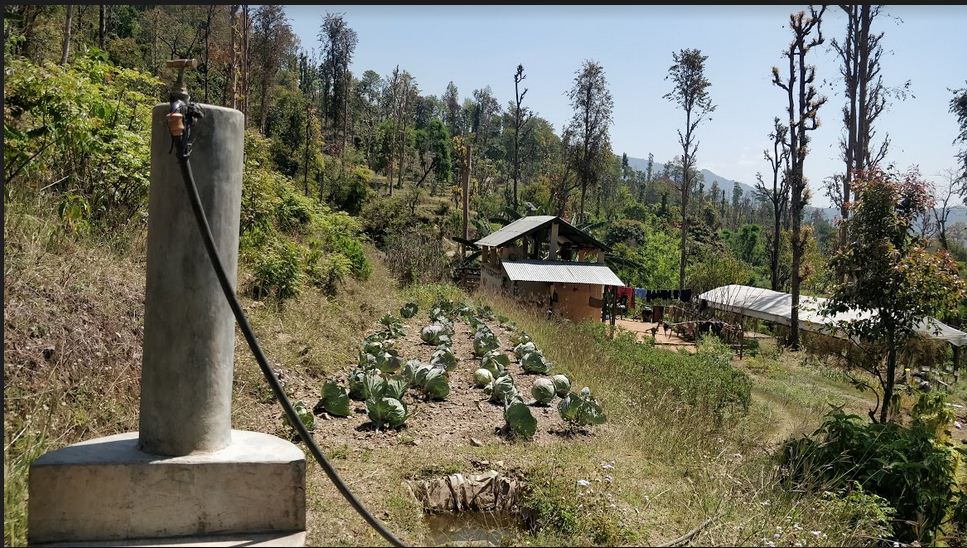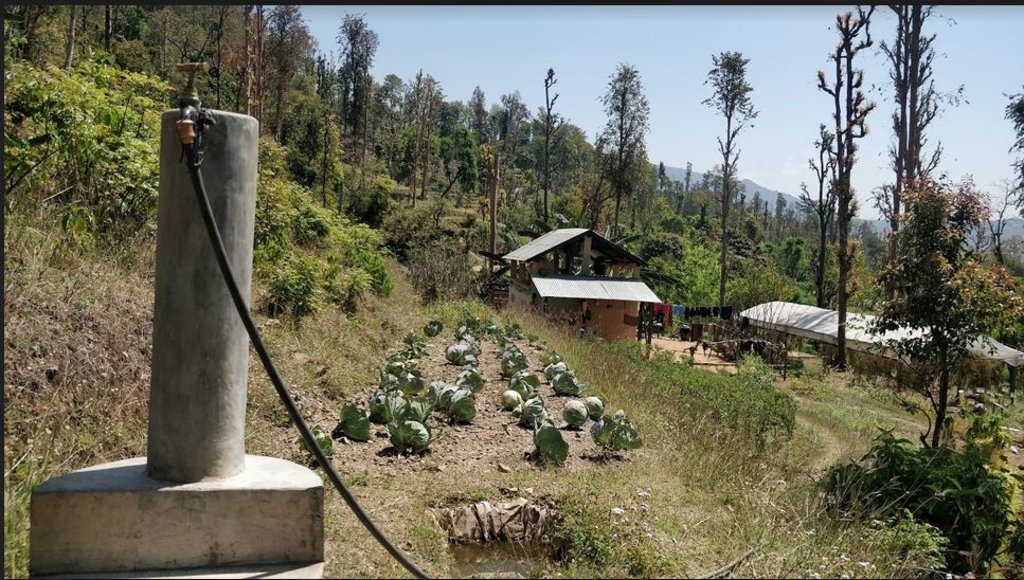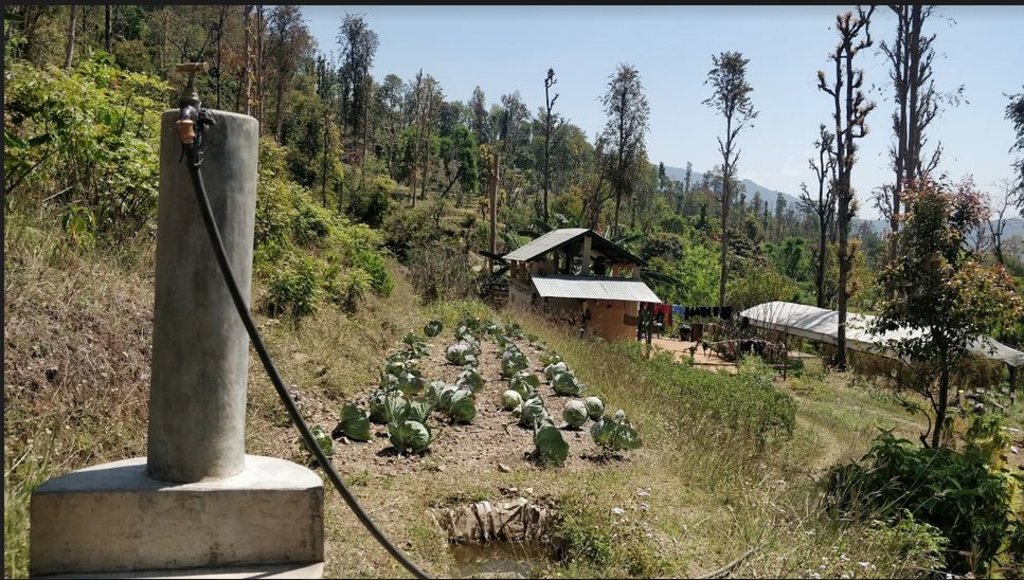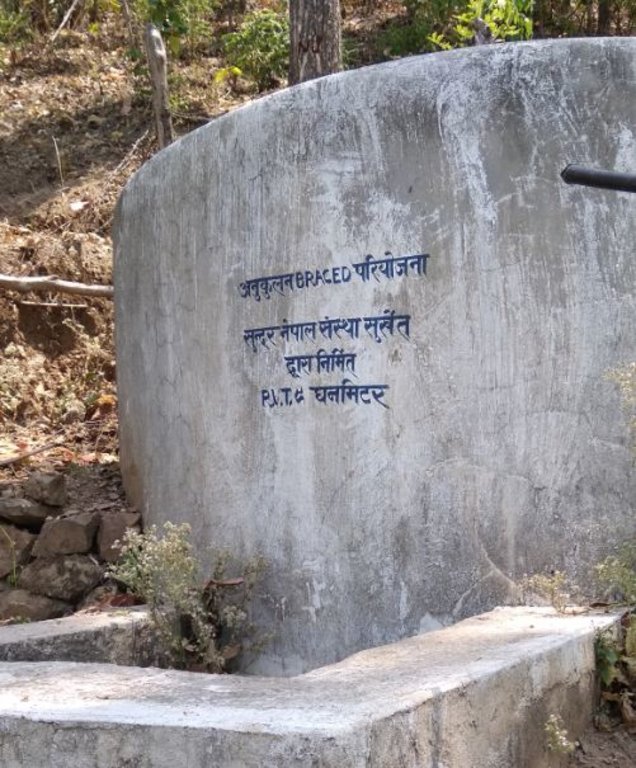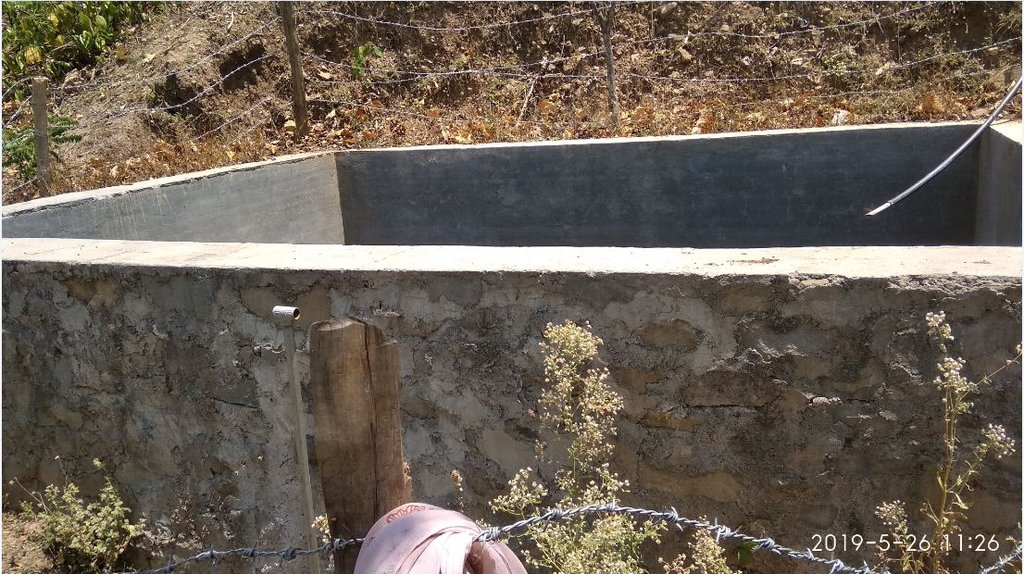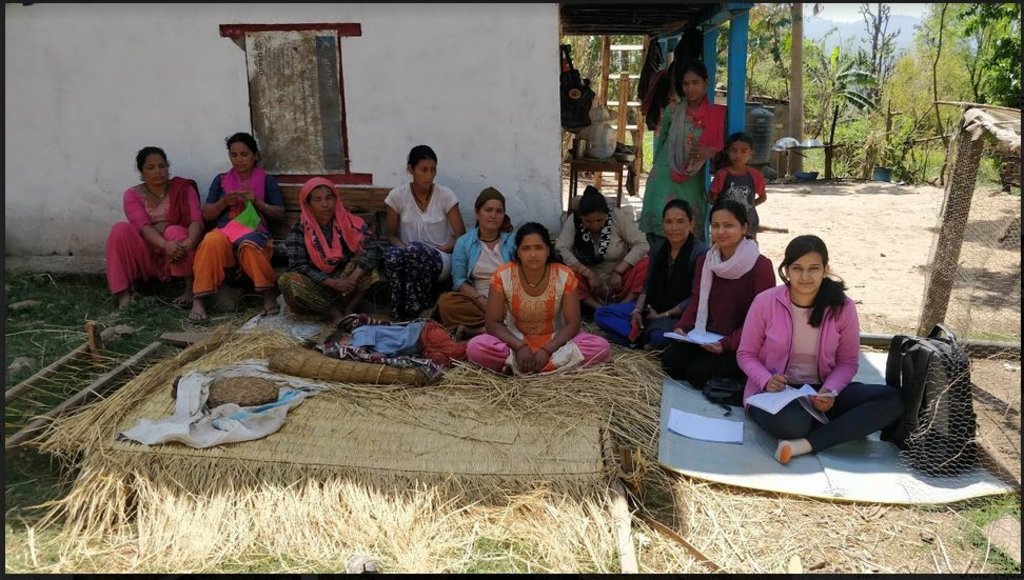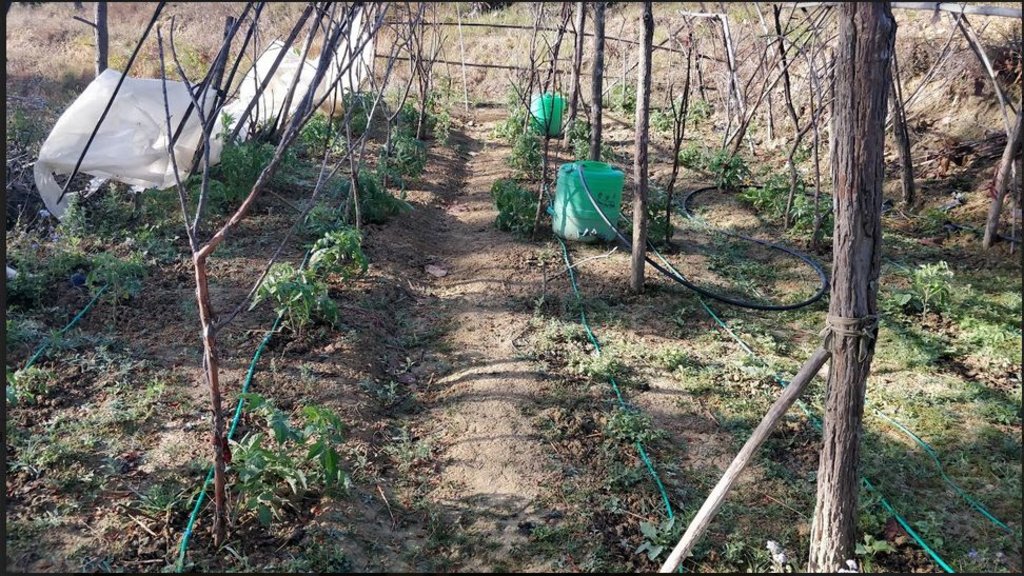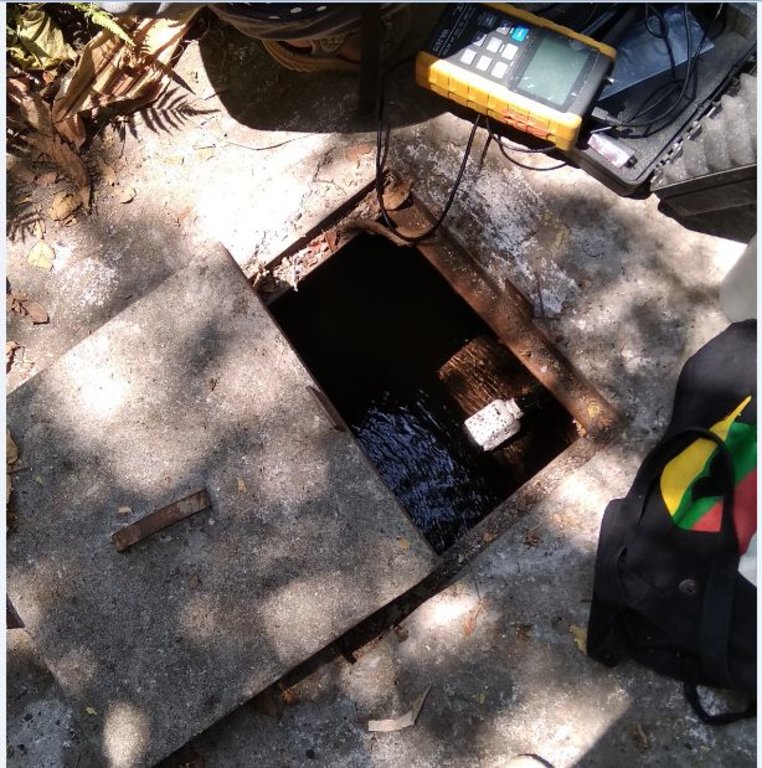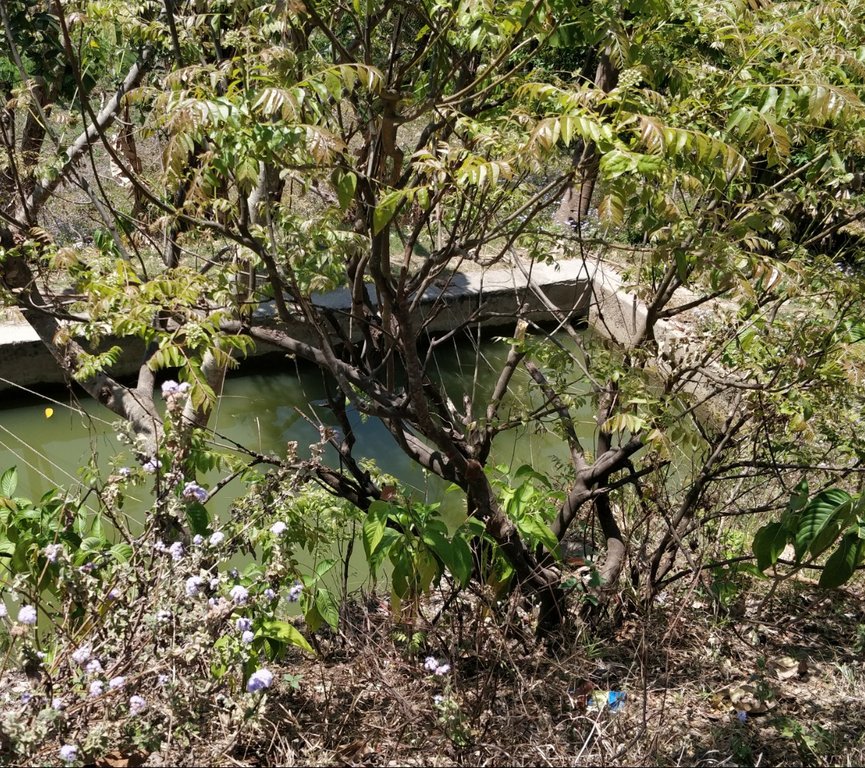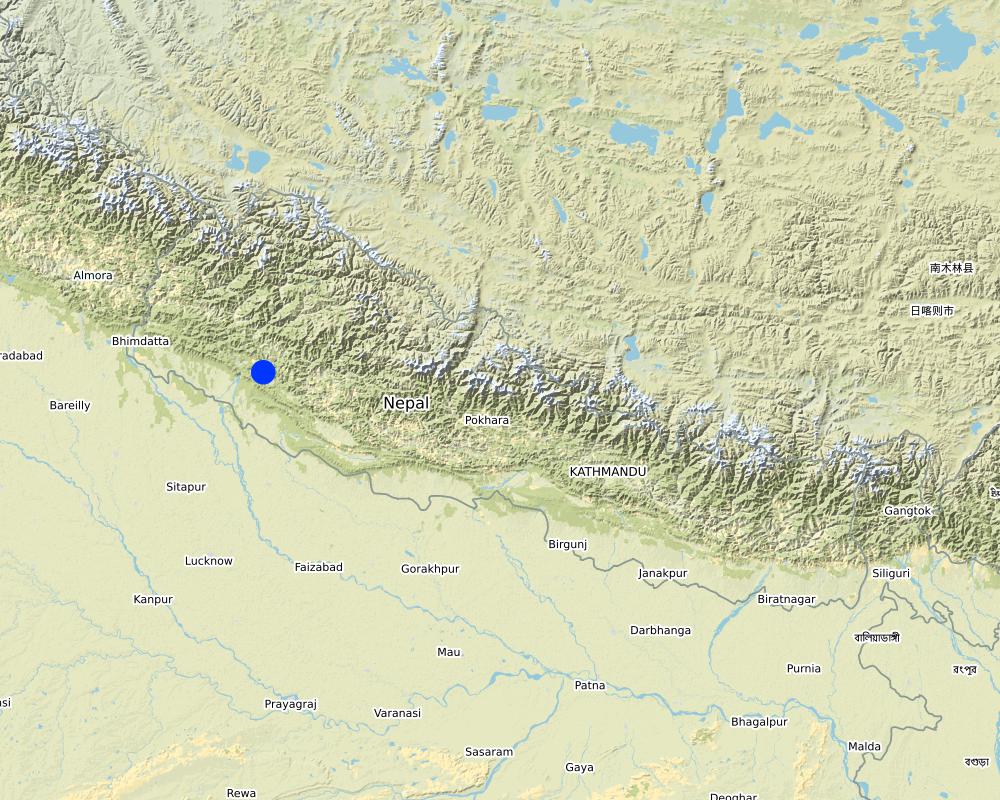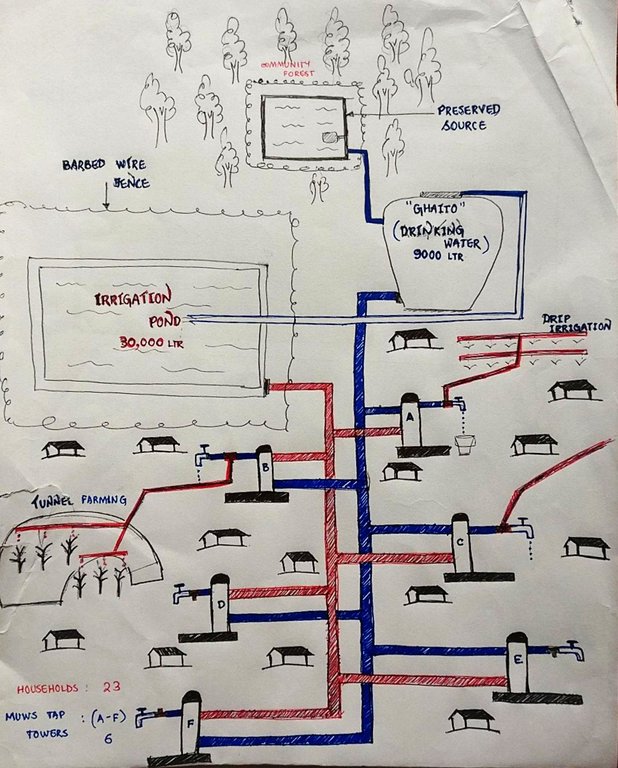Multiple Use Water System ( Gravity-Fed ) [Nepal]
- Criação:
- Atualização:
- Compilador/a: Jhuna Kattel
- Editor: –
- Revisor: Renate Fleiner
Saajh Pani Ghaito
technologies_5200 - Nepal
Veja as seções
Expandir tudo Recolher tudo1. Informação geral
1.2 Detalhes do contato das pessoas capacitadas e instituições envolvidas na avaliação e documentação da tecnologia
Pessoa(s) capacitada(s)
Water User:
B.K. Amrita
Nepal
Nome do projeto que facilitou a documentação/avaliação da Tecnologia (se relevante)
Prospects and challenges of water use systems as climate adaptive option for sustainable water management in Himalayan RegionNome da(s) instituição(ões) que facilitou(ram) a documentação/ avaliação da Tecnologia (se relevante)
Kathmandu University (KU) - Nepal1.3 Condições em relação ao uso da informação documentada através de WOCAT
O/a compilador/a e a(s) pessoa(s) capacitada(s) aceitam as condições relativas ao uso de dados documentados através da WOCAT:
Sim
1.4 Declaração de sustentabilidade da tecnologia descrita
A tecnologia descrita aqui é problemática em relação a degradação da terra de forma que não pode ser declarada uma tecnologia de gestão sustentável de terra?
Não
Comentários:
The technology used serves as a source of providing water for drinking and other multiple uses; such that it acts as a means to conserve and manage water resources rather than degrade them.
2. Descrição da tecnologia de GST
2.1 Descrição curta da tecnologia
Definição da tecnologia:
Natural water source in hill top is collected in a small reservoir-chamber ( to preserve natural source), then passes onto a Reservoir Tank (RVT) for drinking water (ferro-cement tank/ Ghaito) with a capacity of 9000L that falls within individual’s plot of land. When the ferro-cement tank gets filled, water overflows, is collected in another reservoir pond (30,000L) for irrigation and other multiple uses. From the Ghaito and reservoir pond, two pipelines are fed and water is supplied into individual Multiple Use Water System (MUWS) tap towers.
2.2 Descrição detalhada da tecnologia
Descrição:
The technology is applied in a natural environment. The place of study falls under the dry belt of Nepal, receiving less than average annual rainfall (in context of Nepal). The source of water is natural that is located within a community forest area (samudayik ban), which is owned by the government and consists of trees like Sal, Supari (areca nuts), etc. From there, water collects onto a Ghaito / ferro-cement tank, which falls on the land owned by Mr. Krishna Bahadur B.K., who voluntarily agreed to donate the land for its construction. The total area covered for the tank is 1 ropani (1 hectare = 19.65 ropanis). From the reservoir, water is collected in a ferrocement tank / Ghaito / Thulo tanki (for drinking water) and a reservoir pond (for irrigation). Poly Vinyl Chloride (PVC) pipes are fed onto the tanks to distribute the water for multiple purposes in 6 Multiple Use Water System (MUWS) tap-towers; which consist of two faucets each - one for drinking and the other for irrigation and other purposes.
The major purposes of this technology are to supply clean water for drinking and other purposes to the community that is comprised of 23 households, through a cheap, effective and simple system. For establishing the system, labour and construction materials were needed for building Ghaito and pipeline systems. For the maintenance, manual labour is necessary. The natural source of water is locally maintained. The quality of the water that is supplied to the 23 households is good and the quantity seems sufficient for the number of households. Operation and maintenance works are done by the locals who collect NPR. 50 from each household. The system is guarded by a watchman (Chaukidar) who is given a monthly stipend of NPR. 800 from the committee. The system was financed through a public-private-partnership (PPP) program; out of which some amount was funded by a Non-Governmental Organization (NGO) - Sundar Nepal, primary survey of the natural source of water was done by another NGO- Anukulan Project with the help from UK-AID (NPR. 1,46,000) , and the remaining funds were contributed by the locals’ group (NPR. 1,39,183), by collecting NPR. 3000 initially then NPR. 1200 from each household. The then Village Development Committee (VDC) donated NPR. 1,00,000 and labour costs borne by the locals amounted to NPR. 85,600. Total amount invested for the project amounted to NPR. 4,70,783. Benefits of the technology are the sustainable use of water resources through a MUWS system, cheap and effective way to conserve water resources and the ensured availability of clean water even through dry seasons. The villagers like the facts that the water is clean, more water is available for irrigation for vegetable farming, and that their day-to-day life is simplified. They dislike the limited availability of water during dry season and that out of 6 systems only 3 are in operation and the other ones are in a non-working condition.
A separate committee is set up for the smooth operation of the system, which consists of 20 members- 10 males and 10 females. The head of the committee is Mrs. Amrita B.K.. The committee conducts a monthly meeting on 10th of each Nepalese month to discuss the problems and need of maintenance. During the initial setup, the connection of pipelines from the tap systems to the reservoir tanks was, however, done with the contribution of the locals. Every month, each family contributes NPR 50, which goes to a fund that is set up for the times of need. The labor contribution by the people of the VDC was dependent upon the number and availability of family members in the household. Similarly, the use of MUWS system and water from it is also dependent upon the availability of family members. Little to no maintenance was done to the system till now from 2073 B.S. ( 3 years) . Equal number of male and female members are in the committee dedicated to the MUWS system.
2.3 Fotos da tecnologia
Observações gerais sobre as fotos:
Ghaito/ Ferrocemetn tank for drinking water, Irrigation pond, the committee, MUWS tower and tunnels with drip irrigation are shown in the images
2.5 País/região/locais onde a tecnologia foi aplicada e que estão cobertos nesta avaliação
País:
Nepal
Região/Estado/Província:
Province-6, Mid-Western Development Region
Especificação adicional de localização:
Kunathari VDC-5, Saajh Pani, Barahataal, Badichaur
Especifique a difusão da tecnologia:
- Aplicado em pontos específicos/concentrado numa pequena área
O(s) local(is) tecnológico(s) está(ão) localizado(s) em uma área permanentemente protegida?
Não
Map
×2.6 Data da implementação
Indique o ano de implementação:
2015
2.7 Introdução da tecnologia
Especifique como a tecnologia foi introduzida:
- através de projetos/intervenções externas
Comentários (tipos de projeto, etc.):
Sundar Nepal- a non governmental organization helped initiate the project
UKAID ( Anukulan Project) - an inernational non governmental project ( INGO ) helped with the technical aspects of the project
3. Classificação da tecnologia de GST
3.1 Principal/principais finalidade(s) da tecnologia
- Melhora a produção
- Reduz, previne, recupera a degradação do solo
- Adaptar a mudanças climáticas/extremos e seus impactos
- Criar impacto econômico benéfico
- improve water security and increase efficient use at a household level
3.2 Tipo(s) atualizado(s) de uso da terra onde a tecnologia foi aplicada

Terra de cultivo
- Cultura anual
- Cultura perene (não lenhosa)
Cultivo anual - Especificar culturas:
- cereais - cevada
- cereais - milho
- cereais - arroz (zona húmida)
- cereais - trigo (inverno)
Cultivo perene (sem lã) - Especificar culturas:
- areca
- banana/planta/abacá
- cana-de-açúcar
Número de estações de cultivo por ano:
- 3
Especifique:
The water used for irrigation is used in fields for 2-3 cycles of crop growing (annual) like rice, maize and barley and into kitchen-farming/tunnel farming (perennial) where vegetables grown are cucumber, tomatoes, chilli, bitterguard, peas, etc.
O cultivo entre culturas é praticado?
Não
O rodízio de culturas é praticado?
Sim
Caso afirmativo, especifique:
Rice, Maize and Wheat are cycled according to the seasons.

Outros
Especifique:
Drinking Water
Observações:
Drinking water used directly from the tap systems. Some boil it but most of them use it straight from the tap systems and consume without filtration.
Comentários:
Irrigation and Multiple Uses: The locals use the technology in order to irrigate their cropland so that the plant productivity is increased. As well, the introduction of this technology has opened up doors to new possibilities like construction of tunnels ( green houses) so that the locals can grow seasonal and off-seasonal vegetables in their backyards. Animal husbandry has also been an increasing practice. Human uses like washing, cooking, cleaning, bathing, etc are amply sufficient due to adequacy of water from this technology.
3.3 O uso do solo mudou devido à implementação da Tecnologia?
O uso do solo mudou devido à implementação da Tecnologia?
- Sim (Por favor, preencha as perguntas abaixo com relação ao uso do solo antes da implementação da Tecnologia)

Terra de cultivo
- Cultura anual
- Cultura perene (não lenhosa)
Cultivo anual - Especificar culturas:
- cereais - cevada
- cereais - milho
- cereais - arroz (zona húmida)
- cereais - trigo (inverno)
Cultivo perene (sem lã) - Especificar culturas:
- banana/planta/abacá
O cultivo entre culturas é praticado?
Não
O rodízio de culturas é praticado?
Não
Comentários:
Before the introduction of the technology, the land productivity was minimal. Water for human uses like bathing, cleaning, washing, cooking, etc. were scarce; especially during the dry seasons. No green houses were constructed. They used to rear very few cattle.
After the technology, vegetables from green houses in their backyards are sold to markets, which has acted as an alternative source of earning perennially.
3.4 Abastecimento de água
Outros (p. ex. pós-inundação):
- Natural source (Mool) of water in foliage atop a hill that falls under Mr. Krishna Bdr. B.K.'s land
Comentários:
The supply of water comes from a natural source ( 'mool' in local language) , where a small enclosure is constructed so that the source is preserved and water is amply supplied to the ferro-cement tank for drinking purposes ( 'Ghaito' in local language) and the reservoir pond for irrigation purposes.
3.5 Grupo de GST ao qual pertence a tecnologia
- Coleta de água
- Gestão de irrigação (inclusive abastecimento de água, drenagem)
- Gravity Fed Multiple Use Water System (MUWS) , New Scheme
3.6 Medidas de GST contendo a tecnologia

Medidas estruturais
- S5: Represa, bacia, lago
- S6: Muros, barreiras, paliçadas, cercas
- S7: coleta de água/ equipamento de abastecimento/irrigação
- S11: Outros
Comentários:
The technology is comprised of structures like Tanks (ferro-cement), Ponds (Concrete), Pipes, etc which use a myriad of resources like cement, iron rods, PVC pipes, fences for enclosure, etc.
3.7 Principais tipos de degradação da terra abordados pela tecnologia

Degradação da água
- Hs: mudança na quantidade de água de superfície
- Hp: declínio da qualidade de água de superfície
Comentários:
Before setting up the technology, much of the water during dry seasons would evaporate from the natural source ( mool) and there would be scarcity of water during dry seasons. This has been addressed by the technology, where securing the natural source of water prevented evaporation and storing water in enclosed tanks helped supply water during dry seasons.
Similarly, due to no preservation of the source and no storage tanks, the water would be soiled by sediments, wastes and insects' larvae. After setting technology up, the quality of water has vastly improved as well
3.8 Redução, prevenção ou recuperação da degradação do solo
Especifique o objetivo da tecnologia em relação a degradação da terra:
- Prevenir degradação do solo
Comentários:
The technology prevents water source degradation, improves perennial water availability, reduces effects like drought, floods, etc. Thus, land degradation by means of lands turning barren, dry,etc is tackled by this technology.
4. Especificações técnicas, implementação de atividades, entradas e custos
4.1 Desenho técnico da tecnologia
Especificações técnicas (relacionada ao desenho técnico):
Source: Natural (mool) atop a small hill, secured by wire fences and preserved with concrete and metal lid ( to prevent evaporation).
Water from source collected in Ferro-Cement Tank / Reservoir Tank (RVT) / "Ghaito" in local language, with capacity 9000Ltrs.
Water overflows from RVT into an Irrigation Pond (Open Top, Concrete) with capacity 30,000Ltrs.
PVC Pipes leave the RVT and Pond into 6 MUWS Tap Towers ("Thaado" in local language) to serve 23 households.
One faucet supplies drinking water from RVT and next faucet supplies water for irrigation and other multiple purposes (drip irrigation, tunnel farming, etc.).
Autor:
Jhuna Kattel
Data:
26/05/2019
4.2 Informação geral em relação ao cálculo de entradas e custos
Especifique como custos e entradas foram calculados:
- por área de tecnologia
Indique o tamanho e a unidade de área:
5-6 dhurs
Se utilizar uma unidade de área local, indicar fator de conversão para um hectare (por exemplo, 1 ha = 2,47 acres): 1 ha =:
1 hectare = 590.70 dhurs
Outro/moeda nacional (especifique):
NPR
Se for relevante, indique a taxa de câmbio do USD para moeda local (por exemplo, 1 USD = 79,9 Real): 1 USD =:
110,0
Indique a média salarial da mão-de-obra contratada por dia:
N/A ( voluntary labour from each household)
4.3 Atividades de implantação
| Atividade | Periodicidade (estação do ano) | |
|---|---|---|
| 1. | Enclosement for the groundwater source | Summer Season ( Before Rains) |
| 2. | Construction of Ferro-cement tank for Drinking Water | Summer Season ( Before Rains) |
| 3. | Construction of Concrete tank for Irrigation | Summer Season and During Rainy Season |
| 4. | Securing the perimeter for the tanks | Rainy Season |
| 5. | Laying down the PVC pipework | Rainy Season |
| 6. | Construction of 6 individual MUWS tap towers ( Thaado in Nepalese language) | After Rains |
| 7. | Final touch-ups, Setting up faucets, Preliminary checking | After Rains |
Comentários:
A total of roughly 5 months (140 days ) was required for the construction of the technology to be completed.
Construction was initiated before the rains, and could only be completed after the rainy season.
4.4 Custos e entradas necessárias para a implantação
| Especifique a entrada | Unidade | Quantidade | Custos por unidade | Custos totais por entrada | % dos custos arcados pelos usuários da terra | |
|---|---|---|---|---|---|---|
| Mão-de-obra | Labour Costs by Locals | N/A | 1,0 | 85600,0 | 85600,0 | 100,0 |
| Mão-de-obra | Primary Survey and Securing of Source | 1 | 1,0 | 146000,0 | 146000,0 | |
| Equipamento | Construction of Tank, Pond and MUWS Tap Towers | 1 | 1,0 | 100000,0 | 100000,0 | |
| Equipamento | Laying down pipework, Other Construction | 1 | 1,0 | 139183,0 | 139183,0 | 100,0 |
| Custos totais para a implantação da tecnologia | 470783,0 | |||||
| Custos totais para o estabelecimento da Tecnologia em USD | 4279,85 | |||||
Se você não conseguir discriminar os custos na tabela acima, forneça uma estimativa dos custos totais para estabelecer a Tecnologia:
470783,0
Se o usuário da terra arca com menos que 100% dos custos, indique quem cobre os custos remanescentes:
Village Developmment Committee, Anukulan Project (under UK-AID) NGO, Sundar Nepal (NGO)
Comentários:
1.Village Developmment Committee:NPR. 1,00,000
2.Anukulan Project (under UK-AID) NGO: ~ NPR. 1,46,000
3.Water – Users : NPR. 1,39,000 ( collected from households)
4. NPR. 85,600 ( labour costs contributed by the locals)
4.5 Atividades recorrentes/manutenção
| Atividade | Periodicidade/frequência | |
|---|---|---|
| 1. | Pipeline Maintenance Work | During Dry Seasons (Winter) annually |
Comentários:
The maintenance works have been carried out on the pipework for 2-3 times during the winter seasons, wherein the PVC pipes had to be replaced due to the collection of lime inside.
4.6 Custos e entradas necessárias pata a manutenção/atividades recorrentes (por ano)
| Especifique a entrada | Unidade | Quantidade | Custos por unidade | Custos totais por entrada | % dos custos arcados pelos usuários da terra | |
|---|---|---|---|---|---|---|
| Mão-de-obra | Voluntary Labour borne by the Locals | 1 | 1,0 | 100,0 | ||
| Equipamento | PVC Pipes | 1 metres | 400,0 | 30,0 | 12000,0 | 100,0 |
| Custos totais para a manutenção da tecnologia | 12000,0 | |||||
| Custos totais de manutenção da Tecnologia em USD | 109,09 | |||||
Comentários:
The maintenance works were borne by the locals through voluntary contribution, which couldn't be calculated to an exact number. However, estimating the costs of PVC pipes per meter and the number of times they were replaced, the total costs for maintenance came to around 109.09 USD (~ NPR 12,000).
The locals voluntarily agreed for labour required.
4.7 Fatores mais importantes que afetam os custos
Descreva os fatores mais determinantes que afetam os custos:
PVC Pipes costs.
5. Ambiente natural e humano
5.1 Clima
Precipitação pluviométrica anual
- <250 mm
- 251-500 mm
- 501-750 mm
- 751-1.000 mm
- 1.001-1.500 mm
- 1.501-2.000 mm
- 2.001-3.000 mm
- 3.001-4.000 mm
- > 4.000 mm
Especificações/comentários sobre a pluviosidade:
Monsoon/ Rainy Season 2-3 months ( June-August)
Indique o nome da estação meteorológica de referência considerada:
Meteorological Forecasting Division, Nepal ( www.mfd.gov.np)
Zona agroclimática
- Subúmido
The annual total rainfall has been stated as 1609.0mm but, average annual rainfall of the study area couldn't be found in any literature
5.2 Topografia
Declividade média:
- Plano (0-2%)
- Suave ondulado (3-5%)
- Ondulado (6-10%)
- Moderadamente ondulado (11-15%)
- Forte ondulado (16-30%)
- Montanhoso (31-60%)
- Escarpado (>60%)
Formas de relevo:
- Planalto/planície
- Cumes
- Encosta de serra
- Encosta de morro
- Sopés
- Fundos de vale
Zona de altitude:
- 0-100 m s.n.m.
- 101-500 m s.n.m.
- 501-1.000 m s.n.m.
- 1.001-1.500 m s.n.m.
- 1.501-2.000 m s.n.m.
- 2.001-2.500 m s.n.m.
- 2.501-3.000 m s.n.m.
- 3.001-4.000 m s.n.m.
- > 4.000 m s.n.m.
5.3 Solos
Profundidade do solo em média:
- Muito raso (0-20 cm)
- Raso (21-50 cm)
- Moderadamente profundo (51-80 cm)
- Profundo (81-120 cm)
- Muito profundo (>120 cm)
Textura do solo (solo superficial):
- Médio (limoso, siltoso)
- Fino/pesado (argila)
Textura do solo (>20 cm abaixo da superfície):
- Médio (limoso, siltoso)
Matéria orgânica do solo superficial:
- Médio (1-3%)
5.4 Disponibilidade e qualidade de água
Lençol freático:
< 5 m
Disponibilidade de água de superfície:
Bom
Qualidade da água (não tratada):
Água potável boa
A qualidade da água refere-se a:
tanto de águas subterrâneas quanto de superfície
A salinidade da água é um problema?
Não
Ocorre inundação da área?
Não
Comentários e outras especificações sobre a qualidade e a quantidade da água:
Before the introduction of MUWS technology, the water used to be a problem during the dry seasons. However, after the technology was applied, the natural ground water source is conserved, people have been monitoring the water levels cautiously and nowadays, the water sustains the locals during the dry seasons as well.
Salinity is not a problem, but the presence of lime in the water is a problem.
5.5 Biodiversidade
Diversidade de espécies:
- Médio
Diversidade de habitat:
- Médio
Comentários e outras especificações sobre biodiversidade:
Birds are abundant, new fowls are sighted regularly.Lampuchhre ( Long-tailed widowbird),Ravens,Hawks,Peacocks and peafowls,Peasants,Guinea fowls and other fowls; rarely seen before are common after setting up the technology.
Animal sighting is rare. Forests, although consisting of a few varieties of trees, like Saal ( shorea robusta), Sadhana ( Moringa) , Belauti ( Guava), Sallo ( pine tree), Aap ( Mango). very few species are abundant in a given stretch of land.
5.6 Características dos usuários da terra que utilizam a tecnologia
Sedentário ou nômade:
- Semi-nômade
Orientação de mercado do sistema de produção:
- misto (subsistência/comercial)
Rendimento não agrícola:
- 10-50% de toda renda
Nível relativo de riqueza:
- Pobre
Indivíduos ou grupos:
- Indivíduo/unidade familiar
Nível de mecanização:
- Trabalho manual
Gênero:
- Mulheres
- Homens
Idade dos usuários da terra:
- Crianças
- Jovens
- meia-idade
- idosos
Indique outras características relevantes dos usuários da terra:
Members of the community: 1:1 ratio of males to females
Age : mostly middle-aged, a few children and few elderly
Caste/ Ethnicity: Thakuri, Dalit and Janajati
Literacy: few persons completed High – School level (+2), rest are literate ( Class 5)
Total Land Holding: 16 ropanis (1 Hectare = 19.65 ropanis) of land. Human Settlement since last 40+ years in search of better opportunities and access to better services of water, roads, etc.
Total households: 23
Jobs: Males : bread- earners, construction workers, labour, farming
Females: Housewives, Farming. Most of the males in the village have been to foreign country ( India specially) for manual labor and mostly females are present in the village.
Ethnicity: Few families are of Upper- Caste: Thakuris ( as per Nepalese traditions) and most are Dalits and Janajatis; who were considered lower caste previously. But, the caste system has already been abolished from Nepal.
5.7 Área média de terrenos utilizados pelos usuários de terrenos que aplicam a Tecnologia
- < 0,5 ha
- 0,5-1 ha
- 1-2 ha
- 2-5 ha
- 5-15 ha
- 15-50 ha
- 50-100 ha
- 100-500 ha
- 500-1.000 ha
- 1.000-10.000 ha
- > 10.000 ha
É considerado pequena, média ou grande escala (referente ao contexto local)?
- Pequena escala
Comentários:
23 households spread over around 16 ropanis of land
1 hectare = > 19 ropanis
5.8 Propriedade de terra, direitos de uso da terra e de uso da água
Propriedade da terra:
- Indivíduo, não intitulado
- The source, tanks fall under private land area- owned by the Mr. Krishna Bdr. B.K., who voluntarily donated the land
Direitos do uso da terra:
- Comunitário (organizado)
Direitos do uso da água:
- Comunitário (organizado)
Os direitos de uso da terra são baseados em um sistema jurídico tradicional?
Não
Especifique:
Previously, the society had a caste system in which the higher and lower caste discrimination was done and the water tainted by the lower caste ( Dalits, Janajatis) were deemed “unfit” by the upper caste ( Thakuris, Brahmins, Chhetris). However, after the abolishment of the caste system, everyone enjoys equal rights to the access to water.
5.9 Acesso a serviços e infraestrutura
Saúde:
- Pobre
- Moderado
- Bom
Educação:
- Pobre
- Moderado
- Bom
Assistência técnica:
- Pobre
- Moderado
- Bom
Emprego (p. ex. não agrícola):
- Pobre
- Moderado
- Bom
Mercados:
- Pobre
- Moderado
- Bom
Energia:
- Pobre
- Moderado
- Bom
Vias e transporte:
- Pobre
- Moderado
- Bom
Água potável e saneamento:
- Pobre
- Moderado
- Bom
Serviços financeiros:
- Pobre
- Moderado
- Bom
Comentários:
The access to health, education and markets along with other facilities is only accessible after a 15 minute journey to the ‘bazaar’ or market area from the village.
After implementation of the project, people are able to grow vegetables in green houses, annually, and that has added to their source of income.
6. Impactos e declarações finais
6.1 Impactos no local mostrados pela tecnologia
Impactos socioeconômicos
Produção
Produção agrícola
Qualidade da safra
Produção de forragens
Qualidade da forragem
Produção animal
Produção de madeira
Qualidade da floresta/do bosque
Produção florestal não madeireira
Risco de falha de produção
Diversidade de produtos
Área de produção
Gestão de terra
Geração de energia
Disponibilidade e qualidade de água
Disponibilidade de água potável
Qualidade da água potável
Disponibilidade de água para criação de animais
Qualidade da água para criação de animais
Disponibilidade de água para irrigação
Qualidade da água para irrigação
Demanda por água para irrigação
Renda e custos
Despesas com insumos agrícolas
Rendimento agrícola
Diversidade de fontes de rendimento
Disparidades econômicas
Carga de trabalho
Impactos socioculturais
Segurança alimentar/auto-suficiência
Estado de saúde
Direitos do uso da terra/à água
Oportunidades culturais
Oportunidades de lazer
Instituições comunitárias
Instituições nacionais
Conhecimento de GST/ degradação da terra
Atenuação de conflitos
Situação de grupos social e economicamente desfavorecidos
Impactos ecológicos
Ciclo hídrico/escoamento
Quantidade de água
Qualidade de água
Colheita/recolhimento de água
Escoamento superficial
Evaporação
Comentários/especificar:
evaporation of water decreased after the construction of enclosures / tanks.
Solo
Umidade do solo
Cobertura do solo
Perda de solo
Acumulação de solo
Ressecamento/ selagem do solo
Compactação do solo
Ciclo e recarga de nutrientes
Salinidade
Matéria orgânica do solo/carbono abaixo do solo
Acidez
Biodiversidade: vegetação, animais
Cobertura vegetal
Biomassa/carbono acima do solo
Diversidade vegetal
Espécies exóticas invasoras
Diversidade animal
Espécies benéficas
Diversidade de habitat
Controle de praga/doença
Clima e redução de riscos de desastre
Impactos da inundação
Deslizamentos de terra/fluxos de escombros
Impactos da seca
6.2 Impactos externos mostrados pela tecnologia
Especificar a avaliação dos impactos fora do local (medidas):
Since this technology is adapted in a small area, without any significant construction, there is virtually no off-site impact.
However, this technology is bound to show some beneficial impacts (off-site) in the long run.
6.3 Exposição e sensibilidade da tecnologia às mudanças climáticas graduais e extremos/desastres relacionados ao clima (conforme o ponto de vista dos usuários da terra)
Mudança climática gradual
Mudança climática gradual
| Estação do ano | aumento ou diminuição | Como a tecnologia lida com isso? | |
|---|---|---|---|
| Temperatura anual | aumento | moderadamente | |
| Temperatura sazonal | verão | aumento | moderadamente |
| Precipitação pluviométrica anual | redução/diminuição | moderadamente | |
| Precipitação pluviométrica sazonal | estação úmida/das chuvas | redução/diminuição | moderadamente |
Extremos (desastres) relacionados ao clima
Desastres climatológicos
| Como a tecnologia lida com isso? | |
|---|---|
| Seca | bem |
6.4 Análise do custo-benefício
Como os benefícios se comparam aos custos de implantação (do ponto de vista dos usuários da terra)?
Retornos a curto prazo:
positivo
Como os benefícios se comparam aos custos recorrentes/de manutenção(do ponto de vista dos usuários da terra)?
Retornos a curto prazo:
positivo
Comentários:
The system has been in operation since 3 years only. Thus, long term effects are yet to be visible.
The running and maintenance costs were an approximate calculation as per the local water users.
However, it is evident from the running and maintenance costs that the benefits outweigh the costs.
6.6 Adaptação
A tecnologia foi recentemente modificada para adaptar-se as condições variáveis?
Não
6.7 Pontos fortes/vantagens/oportunidades da tecnologia
| Pontos fortes/vantagens/oportunidades na visão do usuário da terra |
|---|
| The system has been in operation since 3 years only. Thus, long term effects are yet to be visible |
| Availability of water even during the dry seasons. |
| Increase in the productivity of perennial vegetables in kitchen garden, construction of tunnels for farming vegetables possible. Hence, new source of income generated by selling vegetables annually. |
| Pontos fortes/vantagens/oportunidades na visão do/a compilador/a ou de outra pessoa capacitada |
|---|
| Increase in the productivity of perennial vegetables in kitchen garden, construction of tunnels for farming vegetables possible |
| Need of alternative sources of water during dry seasons not present after construction of MUWS system |
| Overall productivity of land improved through effective irrigation of water |
| Self-sufficiency in the aspect of water and crops, as well as alternative sources of income increased, improving the quality of lives of the water users. |
6.8 Pontos fracos, desvantagens/riscos da tecnologia e formas de superá-los
| Pontos fracos/desvantagens/riscos na visão do usuário da terra | Como eles podem ser superados? |
|---|---|
| Water levels not rising in few tap systems out of the six constructed | Technician could oversee the problem of elevation and give a viable solution so that 6 out of 6 tap systems could be functional again |
| Pipes breaking down due to lime, and their diameter and quality could be improved | If the government and/or NGO could add to the savings of the group, good quality of Galvanized Iron (GI) pipes could be installed instead of the PVC pipes used |
| Pontos fracos/vantagens/riscos na visão do/a compilador/a ou de outra pessoa capacitada | Como eles podem ser superados? |
|---|---|
| The tank for irrigation is left open at the top, leading to evaporation of water, usually in dry seasons leading to less water in taps during dry seasons | Closing the top of the tank using a lid |
| The pipes used are not sustainable | The use of heavier PVC pipes and/or hybrid GI pipes could result in less chances of system failure due to lime in the water |
7. Referências e links
7.1 Métodos/fontes de informação
- visitas de campo, pesquisas de campo
>10
- entrevistas com usuários de terras
>1
Links e módulos
Expandir tudo Recolher tudoLinks
Não há links
Módulos
Não há módulos


